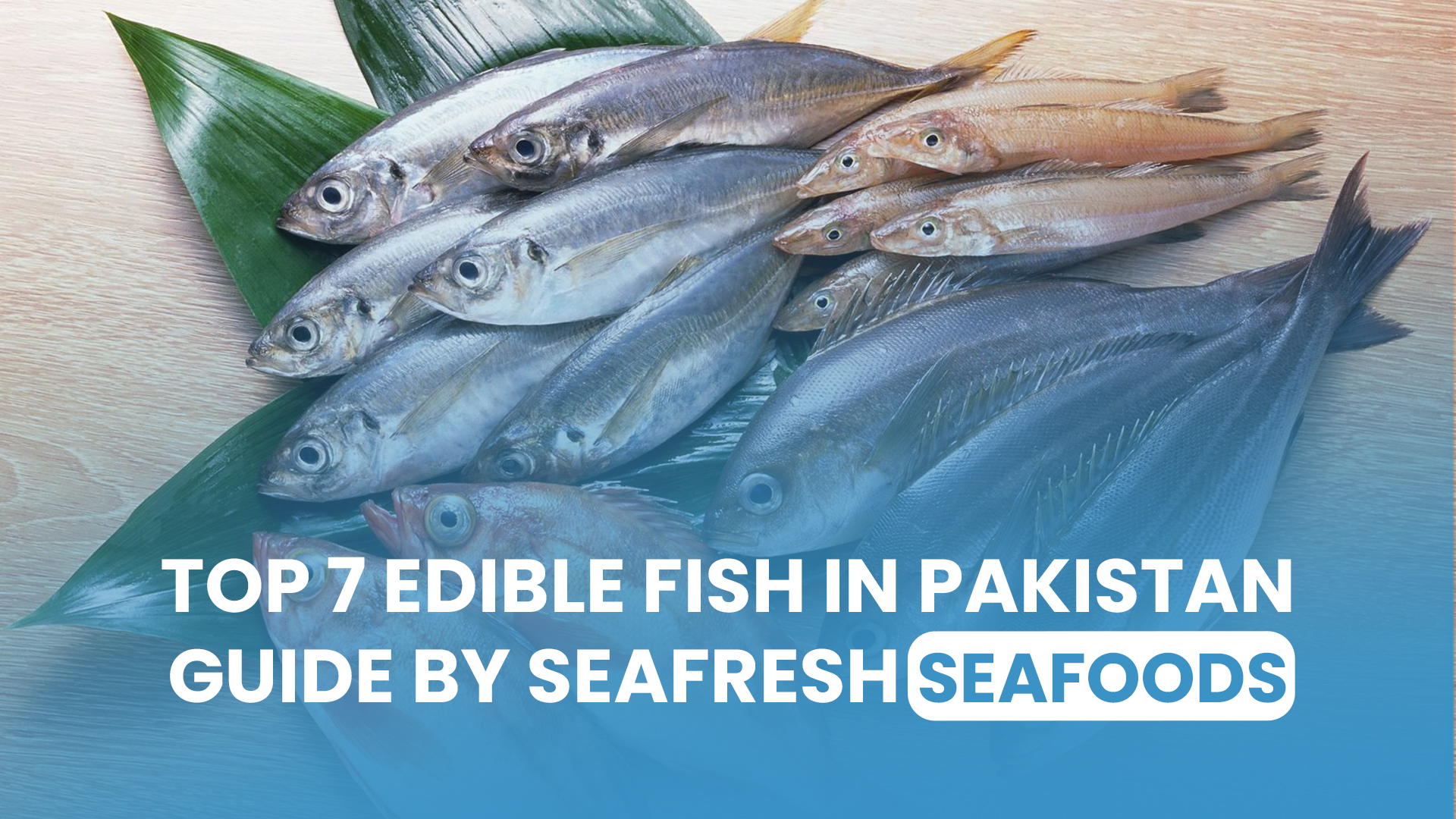Pakistan is a country richly blessed with a long coastline, freshwater rivers, and expansive lakes. These water bodies provide a diverse range of fish that are not only tasty but also incredibly nutritious. Whether you’re a health-conscious eater, a seafood enthusiast, or someone curious about local culinary traditions, exploring Pakistan’s native fish is a delicious and rewarding experience. At Seafresh Seafoods, we celebrate this rich variety by bringing the finest, freshest catches from local waters straight to your kitchen.
In this blog, we dive into the top 7 edible fish in Pakistan. We’ll explore their health benefits, seasonal availability, and the best methods to prepare them.
1. Rahu (Labeo Rohita) – The Classic Freshwater Favorite
Where it’s found: Rivers and freshwater lakes across Punjab and Sindh
Season: Available year-round, with peak freshness in winter
Why it’s appreciated:
Rahu is one of the most commonly consumed freshwater fish in Pakistan. It’s especially popular in Punjab due to its mild flavor, firm texture, and high nutritional content. Packed with Omega-3 fatty acids and essential minerals, Rahu supports strong bones, a healthy heart, and overall vitality. It’s a favorite among families because it’s versatile and easy to cook.
Best prepared as: Fried Rahu masala, Rahu curry, or grilled Rahu steaks
2. Pomfret (Paplet) – The Coastal Delicacy
Where it’s found: Arabian Sea, especially around Karachi and coastal Balochistan
Season: October to March
Why it’s appreciated:
Pomfret comes in two types – Black (Kala Paplet) and White (Safed Paplet). It’s known for its soft, delicate flesh and slightly sweet taste. Low in fat and rich in selenium and iodine, Pomfret is ideal for those watching their fat intake while still wanting a flavorful meal.
Best cooked as: Grilled with lemon and spices, or shallow-fried with light marinade
3. Surmai (Kingfish or Spanish Mackerel) – The Gourmet’s Choice
Where it’s found: Arabian Sea
Season: October to February
Why it’s appreciated:
Surmai is considered a luxury seafood item in Pakistan. With minimal bones and a firm, meaty texture, it’s easy to prepare and immensely satisfying. Surmai is rich in Omega-3 and Vitamin D, promoting heart health and boosting brain function.
Best prepared as: Grilled steaks, Surmai masala curry, or lemon-pepper Surmai
4. Mahseer (Tor Putitora) – The King of Rivers
Where it’s found: Northern rivers like the Indus and Swat
Season: Primarily in winter
Why it’s appreciated:
Mahseer is the national fish of Pakistan, highly valued for its firm texture and high protein and iron content. It supports muscle growth, mental performance, and general well-being. It’s a prized catch among anglers and a delicacy in northern cuisines.
Best cooked as: Steamed with herbs, barbecued, or slow-cooked in spicy gravy
5. Trout – The Northern Treasure
Where it’s found: Cold rivers and streams in Gilgit-Baltistan and Azad Kashmir
Season: Late autumn through spring
Why it’s appreciated:
Trout is popular in northern Pakistan and is often farmed in freshwater hatcheries. It’s a lean fish with high Omega-3 content and is excellent for cardiovascular and skin health. It also has a light, clean taste that pairs well with simple seasonings.
Best prepared as: Pan-fried with lemon butter, grilled with herbs, or baked with garlic
6. Singhara (Catfish) – The Riverbed Favorite
Where it’s found: Rivers and ponds throughout Punjab and Sindh
Season: Especially available in monsoon and post-monsoon periods
Why it’s appreciated:
Singhara, or catfish, is valued for its unique taste and soft texture. It’s high in protein and low in carbs, making it a great choice for low-carb diets. Catfish is also a rich source of vitamin B12 and is known for its ability to stay fresh longer when cooked.
Best cooked as: Deep-fried Singhara, curry-style Singhara, or spiced skewers
7. Mullet (Boal or Sheedi) – The Underrated Local Catch
Where it’s found: Coastal waters and brackish estuaries in Sindh
Season: Year-round, best during pre-winter months
Why it’s appreciated:
Mullet is often underrated, but its firm flesh and rich taste make it a hidden gem. It’s rich in Omega-3s and phosphorus, supporting bone and brain health. Mullet is usually affordable and widely available.
Best cooked as: Roasted whole with spices, stewed in tomato-based gravy, or grilled
Health Benefits of Eating Fish
Consuming fish regularly is one of the healthiest dietary habits. Here are a few scientifically supported benefits:
- Heart Health: Omega-3 fatty acids reduce the risk of cardiovascular disease
- Brain Function: Improves memory, focus, and mood
- Cholesterol Control: Helps balance HDL and LDL cholesterol
- Micronutrient Boost: Rich in iodine, selenium, and vitamin D
- Healthy Skin and Hair: Enhances glow and prevents dryness
Cooking Tips for Pakistani Fish
- Always buy fish that’s fresh or flash-frozen to preserve taste and nutrition
- Marinate for at least 30 minutes before grilling or frying for deeper flavor
- Use local spices like turmeric, cumin, and coriander to enhance natural taste
- Avoid overcooking, which can make fish dry and reduce nutrient value
Where to Buy Fresh, Quality Fish in Pakistan
Looking for trustworthy seafood delivery in Pakistan? SeaFresh.pk is your one-stop shop. Whether it’s Pomfret, Surmai, or Rahu, they offer a wide range of freshly caught, cleaned, and hygienically packed fish. Delivered right to your door, SeaFresh ensures you enjoy the flavor of the ocean without stepping outside.
Their service is available across major cities and perfect for both home cooks and restaurants.
Conclusion:
Whether you’re discovering local flavors or adding healthy protein to your diet, Pakistan’s fish variety is truly impressive. From the rivers of Punjab to the coasts of Karachi, there’s a delicious and nutritious fish for every plate.
